Quality Management in Business (Unit 17): A Report for HND Hospitality
VerifiedAdded on 2023/06/15
|16
|4496
|228
Report
AI Summary
This report provides a comprehensive overview of quality management in business, focusing on definitions of quality, the roles of quality control and assurance, and approaches to improve quality management. It explores the philosophies of Juran, Deming, and Crosby, highlighting their similarities and differences. The report also discusses customer satisfaction, continuous improvement, and the importance of effective marketing and information dissemination to customers. The analysis covers key concepts such as quality planning, quality control, quality improvement, and the PDCA cycle, offering insights into how organizations can enhance productivity and ensure customer loyalty. Desklib offers more resources for students.
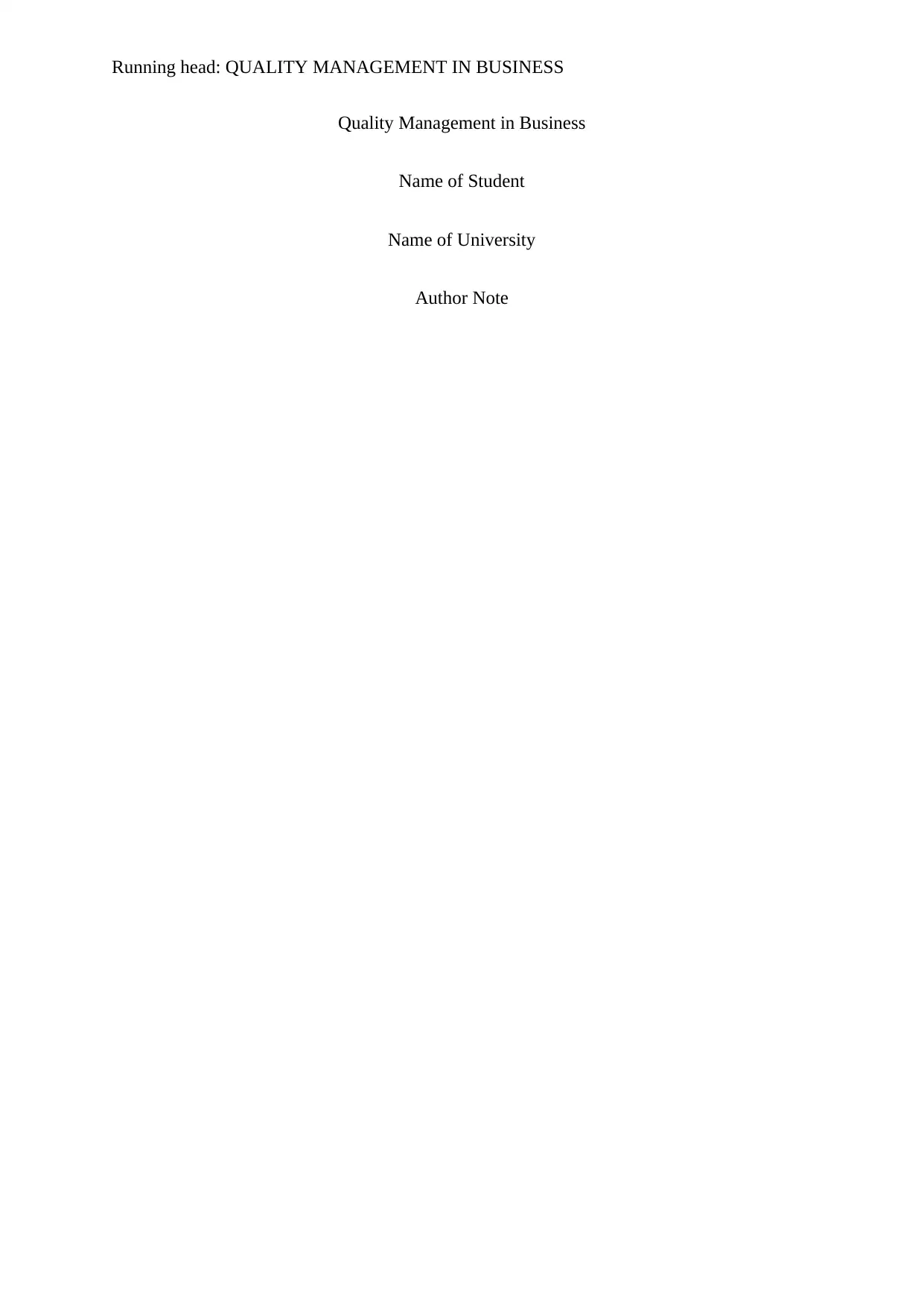
Running head: QUALITY MANAGEMENT IN BUSINESS
Quality Management in Business
Name of Student
Name of University
Author Note
Quality Management in Business
Name of Student
Name of University
Author Note
Paraphrase This Document
Need a fresh take? Get an instant paraphrase of this document with our AI Paraphraser
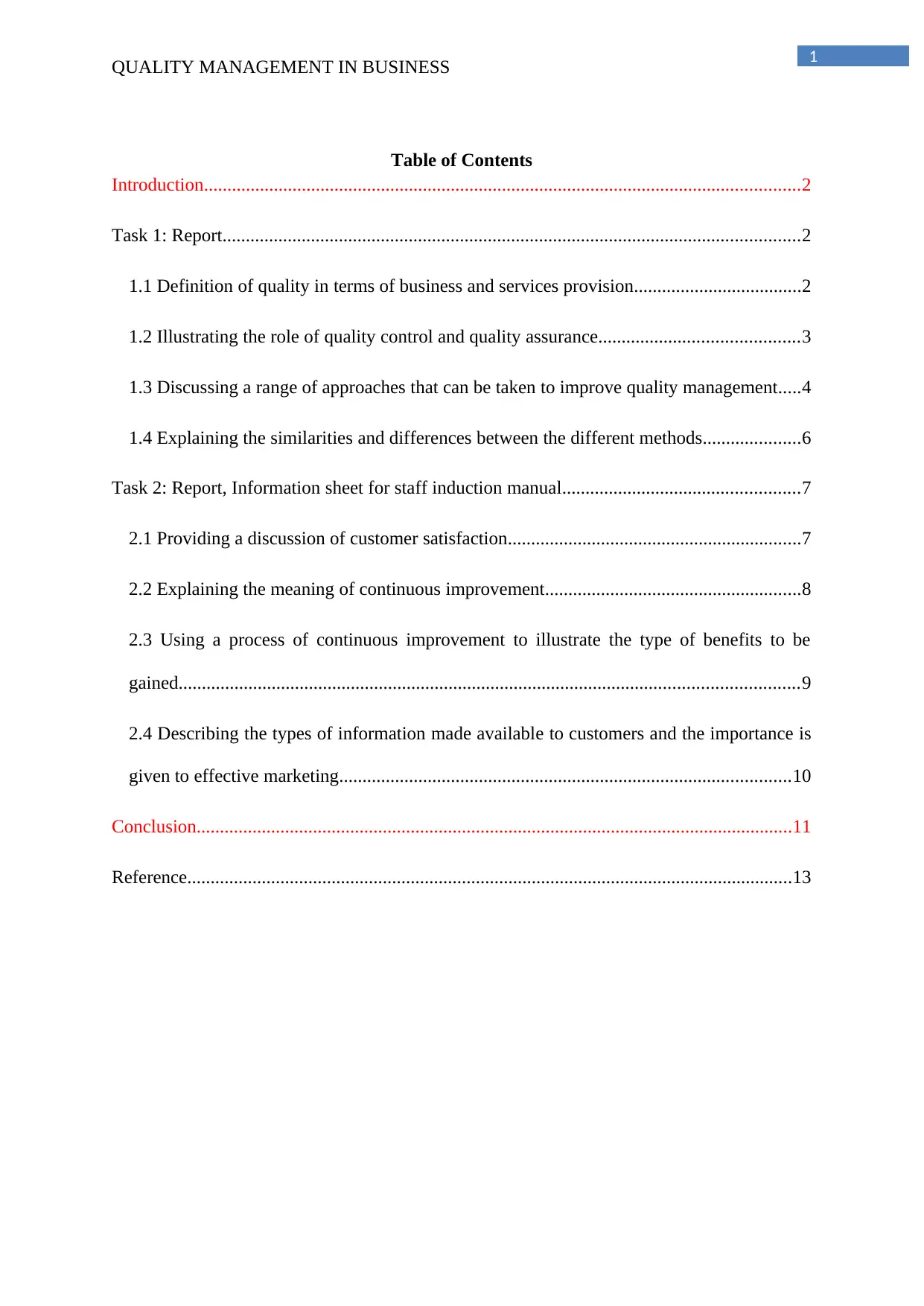
1
QUALITY MANAGEMENT IN BUSINESS
Table of Contents
Introduction................................................................................................................................2
Task 1: Report............................................................................................................................2
1.1 Definition of quality in terms of business and services provision....................................2
1.2 Illustrating the role of quality control and quality assurance...........................................3
1.3 Discussing a range of approaches that can be taken to improve quality management.....4
1.4 Explaining the similarities and differences between the different methods.....................6
Task 2: Report, Information sheet for staff induction manual...................................................7
2.1 Providing a discussion of customer satisfaction...............................................................7
2.2 Explaining the meaning of continuous improvement.......................................................8
2.3 Using a process of continuous improvement to illustrate the type of benefits to be
gained.....................................................................................................................................9
2.4 Describing the types of information made available to customers and the importance is
given to effective marketing.................................................................................................10
Conclusion................................................................................................................................11
Reference..................................................................................................................................13
QUALITY MANAGEMENT IN BUSINESS
Table of Contents
Introduction................................................................................................................................2
Task 1: Report............................................................................................................................2
1.1 Definition of quality in terms of business and services provision....................................2
1.2 Illustrating the role of quality control and quality assurance...........................................3
1.3 Discussing a range of approaches that can be taken to improve quality management.....4
1.4 Explaining the similarities and differences between the different methods.....................6
Task 2: Report, Information sheet for staff induction manual...................................................7
2.1 Providing a discussion of customer satisfaction...............................................................7
2.2 Explaining the meaning of continuous improvement.......................................................8
2.3 Using a process of continuous improvement to illustrate the type of benefits to be
gained.....................................................................................................................................9
2.4 Describing the types of information made available to customers and the importance is
given to effective marketing.................................................................................................10
Conclusion................................................................................................................................11
Reference..................................................................................................................................13
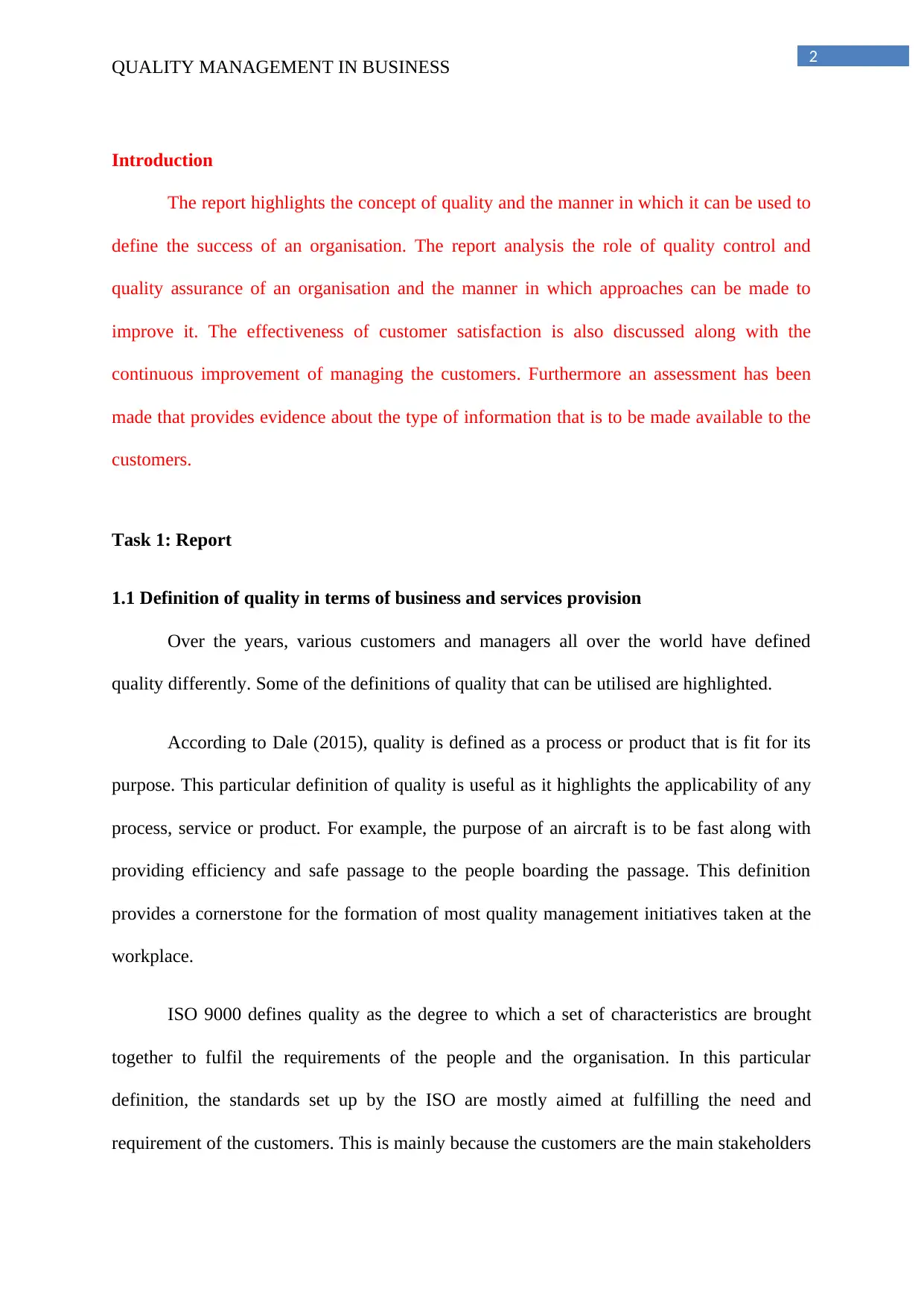
2
QUALITY MANAGEMENT IN BUSINESS
Introduction
The report highlights the concept of quality and the manner in which it can be used to
define the success of an organisation. The report analysis the role of quality control and
quality assurance of an organisation and the manner in which approaches can be made to
improve it. The effectiveness of customer satisfaction is also discussed along with the
continuous improvement of managing the customers. Furthermore an assessment has been
made that provides evidence about the type of information that is to be made available to the
customers.
Task 1: Report
1.1 Definition of quality in terms of business and services provision
Over the years, various customers and managers all over the world have defined
quality differently. Some of the definitions of quality that can be utilised are highlighted.
According to Dale (2015), quality is defined as a process or product that is fit for its
purpose. This particular definition of quality is useful as it highlights the applicability of any
process, service or product. For example, the purpose of an aircraft is to be fast along with
providing efficiency and safe passage to the people boarding the passage. This definition
provides a cornerstone for the formation of most quality management initiatives taken at the
workplace.
ISO 9000 defines quality as the degree to which a set of characteristics are brought
together to fulfil the requirements of the people and the organisation. In this particular
definition, the standards set up by the ISO are mostly aimed at fulfilling the need and
requirement of the customers. This is mainly because the customers are the main stakeholders
QUALITY MANAGEMENT IN BUSINESS
Introduction
The report highlights the concept of quality and the manner in which it can be used to
define the success of an organisation. The report analysis the role of quality control and
quality assurance of an organisation and the manner in which approaches can be made to
improve it. The effectiveness of customer satisfaction is also discussed along with the
continuous improvement of managing the customers. Furthermore an assessment has been
made that provides evidence about the type of information that is to be made available to the
customers.
Task 1: Report
1.1 Definition of quality in terms of business and services provision
Over the years, various customers and managers all over the world have defined
quality differently. Some of the definitions of quality that can be utilised are highlighted.
According to Dale (2015), quality is defined as a process or product that is fit for its
purpose. This particular definition of quality is useful as it highlights the applicability of any
process, service or product. For example, the purpose of an aircraft is to be fast along with
providing efficiency and safe passage to the people boarding the passage. This definition
provides a cornerstone for the formation of most quality management initiatives taken at the
workplace.
ISO 9000 defines quality as the degree to which a set of characteristics are brought
together to fulfil the requirements of the people and the organisation. In this particular
definition, the standards set up by the ISO are mostly aimed at fulfilling the need and
requirement of the customers. This is mainly because the customers are the main stakeholders
⊘ This is a preview!⊘
Do you want full access?
Subscribe today to unlock all pages.

Trusted by 1+ million students worldwide
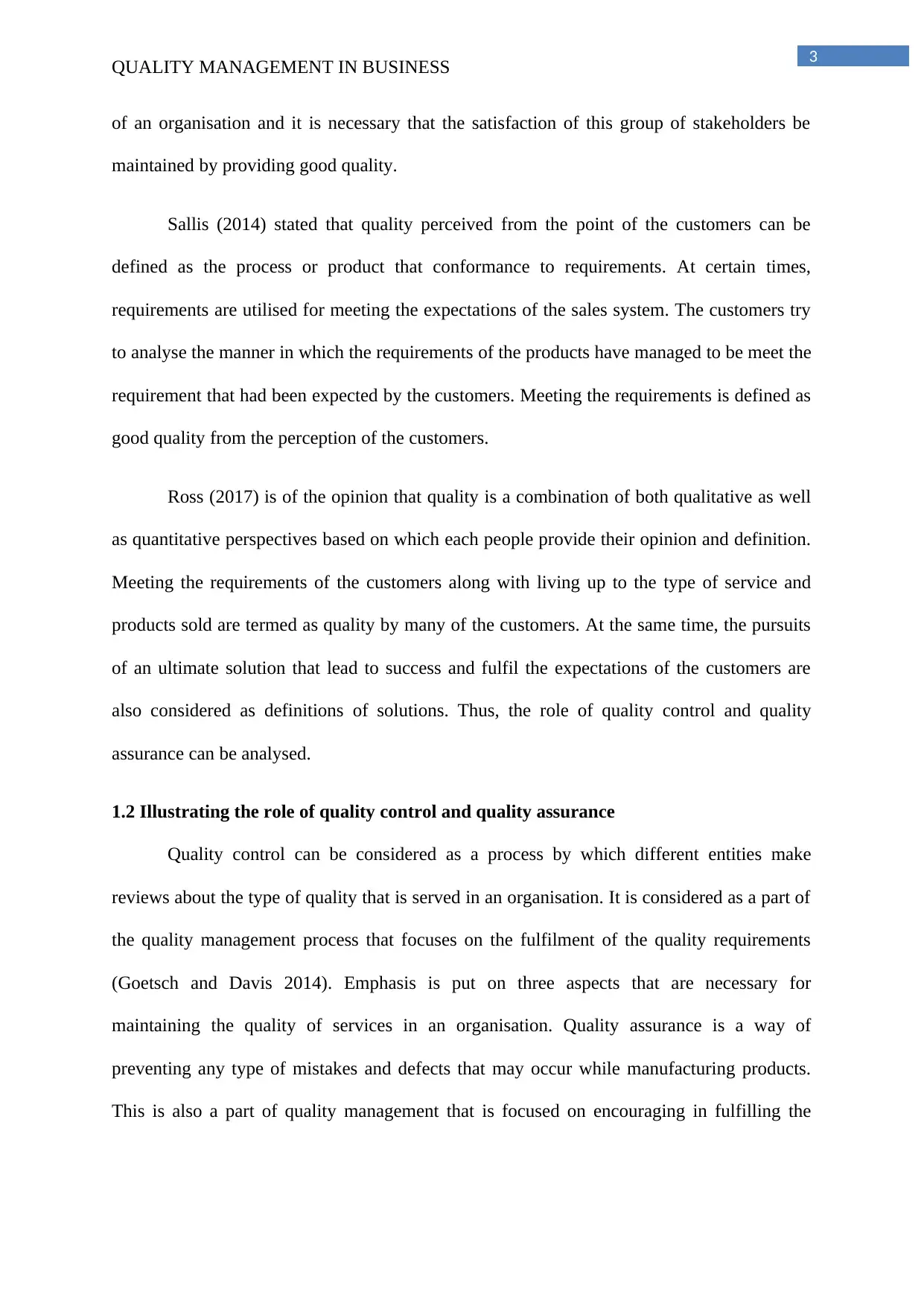
3
QUALITY MANAGEMENT IN BUSINESS
of an organisation and it is necessary that the satisfaction of this group of stakeholders be
maintained by providing good quality.
Sallis (2014) stated that quality perceived from the point of the customers can be
defined as the process or product that conformance to requirements. At certain times,
requirements are utilised for meeting the expectations of the sales system. The customers try
to analyse the manner in which the requirements of the products have managed to be meet the
requirement that had been expected by the customers. Meeting the requirements is defined as
good quality from the perception of the customers.
Ross (2017) is of the opinion that quality is a combination of both qualitative as well
as quantitative perspectives based on which each people provide their opinion and definition.
Meeting the requirements of the customers along with living up to the type of service and
products sold are termed as quality by many of the customers. At the same time, the pursuits
of an ultimate solution that lead to success and fulfil the expectations of the customers are
also considered as definitions of solutions. Thus, the role of quality control and quality
assurance can be analysed.
1.2 Illustrating the role of quality control and quality assurance
Quality control can be considered as a process by which different entities make
reviews about the type of quality that is served in an organisation. It is considered as a part of
the quality management process that focuses on the fulfilment of the quality requirements
(Goetsch and Davis 2014). Emphasis is put on three aspects that are necessary for
maintaining the quality of services in an organisation. Quality assurance is a way of
preventing any type of mistakes and defects that may occur while manufacturing products.
This is also a part of quality management that is focused on encouraging in fulfilling the
QUALITY MANAGEMENT IN BUSINESS
of an organisation and it is necessary that the satisfaction of this group of stakeholders be
maintained by providing good quality.
Sallis (2014) stated that quality perceived from the point of the customers can be
defined as the process or product that conformance to requirements. At certain times,
requirements are utilised for meeting the expectations of the sales system. The customers try
to analyse the manner in which the requirements of the products have managed to be meet the
requirement that had been expected by the customers. Meeting the requirements is defined as
good quality from the perception of the customers.
Ross (2017) is of the opinion that quality is a combination of both qualitative as well
as quantitative perspectives based on which each people provide their opinion and definition.
Meeting the requirements of the customers along with living up to the type of service and
products sold are termed as quality by many of the customers. At the same time, the pursuits
of an ultimate solution that lead to success and fulfil the expectations of the customers are
also considered as definitions of solutions. Thus, the role of quality control and quality
assurance can be analysed.
1.2 Illustrating the role of quality control and quality assurance
Quality control can be considered as a process by which different entities make
reviews about the type of quality that is served in an organisation. It is considered as a part of
the quality management process that focuses on the fulfilment of the quality requirements
(Goetsch and Davis 2014). Emphasis is put on three aspects that are necessary for
maintaining the quality of services in an organisation. Quality assurance is a way of
preventing any type of mistakes and defects that may occur while manufacturing products.
This is also a part of quality management that is focused on encouraging in fulfilling the
Paraphrase This Document
Need a fresh take? Get an instant paraphrase of this document with our AI Paraphraser
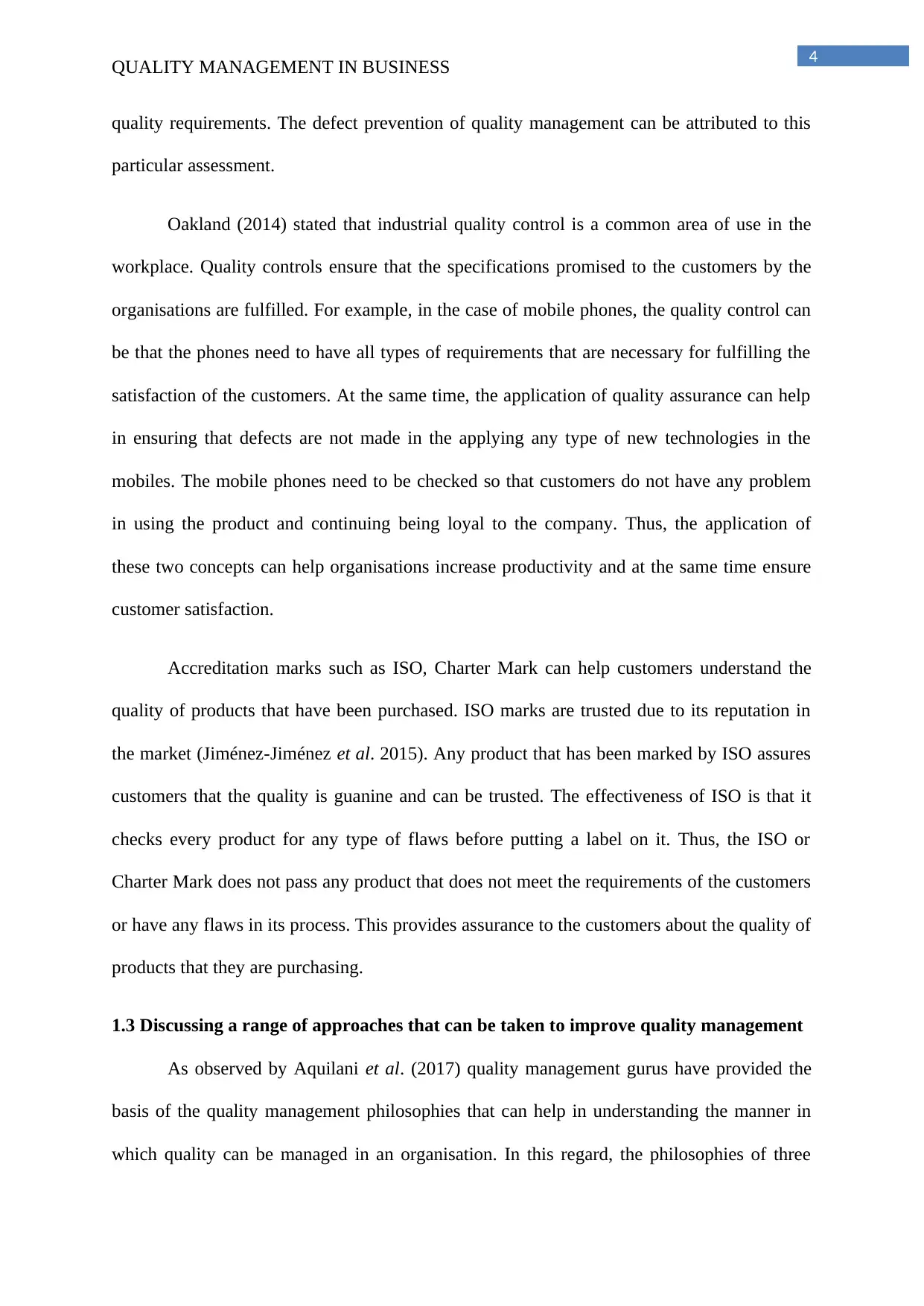
4
QUALITY MANAGEMENT IN BUSINESS
quality requirements. The defect prevention of quality management can be attributed to this
particular assessment.
Oakland (2014) stated that industrial quality control is a common area of use in the
workplace. Quality controls ensure that the specifications promised to the customers by the
organisations are fulfilled. For example, in the case of mobile phones, the quality control can
be that the phones need to have all types of requirements that are necessary for fulfilling the
satisfaction of the customers. At the same time, the application of quality assurance can help
in ensuring that defects are not made in the applying any type of new technologies in the
mobiles. The mobile phones need to be checked so that customers do not have any problem
in using the product and continuing being loyal to the company. Thus, the application of
these two concepts can help organisations increase productivity and at the same time ensure
customer satisfaction.
Accreditation marks such as ISO, Charter Mark can help customers understand the
quality of products that have been purchased. ISO marks are trusted due to its reputation in
the market (Jiménez-Jiménez et al. 2015). Any product that has been marked by ISO assures
customers that the quality is guanine and can be trusted. The effectiveness of ISO is that it
checks every product for any type of flaws before putting a label on it. Thus, the ISO or
Charter Mark does not pass any product that does not meet the requirements of the customers
or have any flaws in its process. This provides assurance to the customers about the quality of
products that they are purchasing.
1.3 Discussing a range of approaches that can be taken to improve quality management
As observed by Aquilani et al. (2017) quality management gurus have provided the
basis of the quality management philosophies that can help in understanding the manner in
which quality can be managed in an organisation. In this regard, the philosophies of three
QUALITY MANAGEMENT IN BUSINESS
quality requirements. The defect prevention of quality management can be attributed to this
particular assessment.
Oakland (2014) stated that industrial quality control is a common area of use in the
workplace. Quality controls ensure that the specifications promised to the customers by the
organisations are fulfilled. For example, in the case of mobile phones, the quality control can
be that the phones need to have all types of requirements that are necessary for fulfilling the
satisfaction of the customers. At the same time, the application of quality assurance can help
in ensuring that defects are not made in the applying any type of new technologies in the
mobiles. The mobile phones need to be checked so that customers do not have any problem
in using the product and continuing being loyal to the company. Thus, the application of
these two concepts can help organisations increase productivity and at the same time ensure
customer satisfaction.
Accreditation marks such as ISO, Charter Mark can help customers understand the
quality of products that have been purchased. ISO marks are trusted due to its reputation in
the market (Jiménez-Jiménez et al. 2015). Any product that has been marked by ISO assures
customers that the quality is guanine and can be trusted. The effectiveness of ISO is that it
checks every product for any type of flaws before putting a label on it. Thus, the ISO or
Charter Mark does not pass any product that does not meet the requirements of the customers
or have any flaws in its process. This provides assurance to the customers about the quality of
products that they are purchasing.
1.3 Discussing a range of approaches that can be taken to improve quality management
As observed by Aquilani et al. (2017) quality management gurus have provided the
basis of the quality management philosophies that can help in understanding the manner in
which quality can be managed in an organisation. In this regard, the philosophies of three
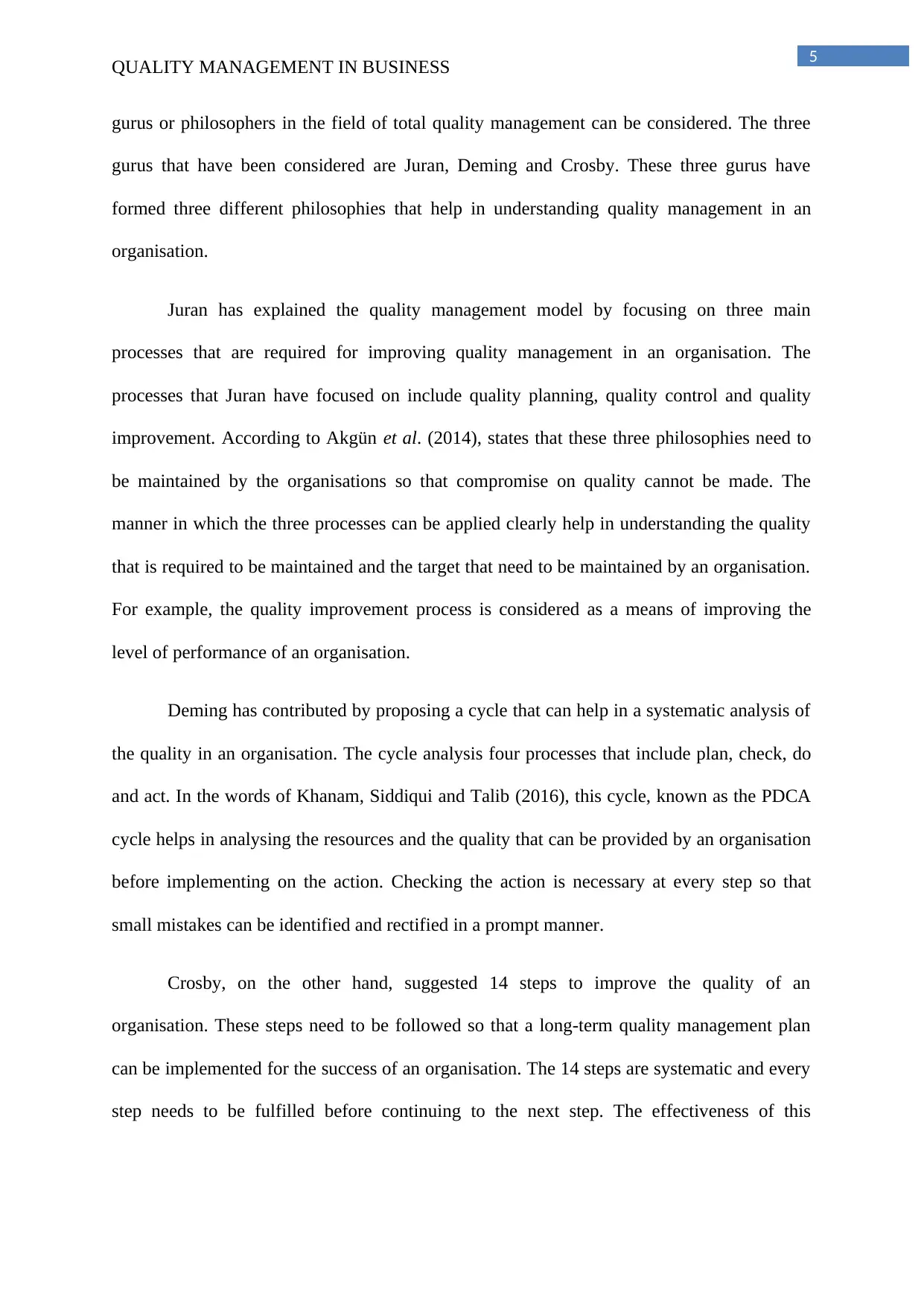
5
QUALITY MANAGEMENT IN BUSINESS
gurus or philosophers in the field of total quality management can be considered. The three
gurus that have been considered are Juran, Deming and Crosby. These three gurus have
formed three different philosophies that help in understanding quality management in an
organisation.
Juran has explained the quality management model by focusing on three main
processes that are required for improving quality management in an organisation. The
processes that Juran have focused on include quality planning, quality control and quality
improvement. According to Akgün et al. (2014), states that these three philosophies need to
be maintained by the organisations so that compromise on quality cannot be made. The
manner in which the three processes can be applied clearly help in understanding the quality
that is required to be maintained and the target that need to be maintained by an organisation.
For example, the quality improvement process is considered as a means of improving the
level of performance of an organisation.
Deming has contributed by proposing a cycle that can help in a systematic analysis of
the quality in an organisation. The cycle analysis four processes that include plan, check, do
and act. In the words of Khanam, Siddiqui and Talib (2016), this cycle, known as the PDCA
cycle helps in analysing the resources and the quality that can be provided by an organisation
before implementing on the action. Checking the action is necessary at every step so that
small mistakes can be identified and rectified in a prompt manner.
Crosby, on the other hand, suggested 14 steps to improve the quality of an
organisation. These steps need to be followed so that a long-term quality management plan
can be implemented for the success of an organisation. The 14 steps are systematic and every
step needs to be fulfilled before continuing to the next step. The effectiveness of this
QUALITY MANAGEMENT IN BUSINESS
gurus or philosophers in the field of total quality management can be considered. The three
gurus that have been considered are Juran, Deming and Crosby. These three gurus have
formed three different philosophies that help in understanding quality management in an
organisation.
Juran has explained the quality management model by focusing on three main
processes that are required for improving quality management in an organisation. The
processes that Juran have focused on include quality planning, quality control and quality
improvement. According to Akgün et al. (2014), states that these three philosophies need to
be maintained by the organisations so that compromise on quality cannot be made. The
manner in which the three processes can be applied clearly help in understanding the quality
that is required to be maintained and the target that need to be maintained by an organisation.
For example, the quality improvement process is considered as a means of improving the
level of performance of an organisation.
Deming has contributed by proposing a cycle that can help in a systematic analysis of
the quality in an organisation. The cycle analysis four processes that include plan, check, do
and act. In the words of Khanam, Siddiqui and Talib (2016), this cycle, known as the PDCA
cycle helps in analysing the resources and the quality that can be provided by an organisation
before implementing on the action. Checking the action is necessary at every step so that
small mistakes can be identified and rectified in a prompt manner.
Crosby, on the other hand, suggested 14 steps to improve the quality of an
organisation. These steps need to be followed so that a long-term quality management plan
can be implemented for the success of an organisation. The 14 steps are systematic and every
step needs to be fulfilled before continuing to the next step. The effectiveness of this
⊘ This is a preview!⊘
Do you want full access?
Subscribe today to unlock all pages.

Trusted by 1+ million students worldwide
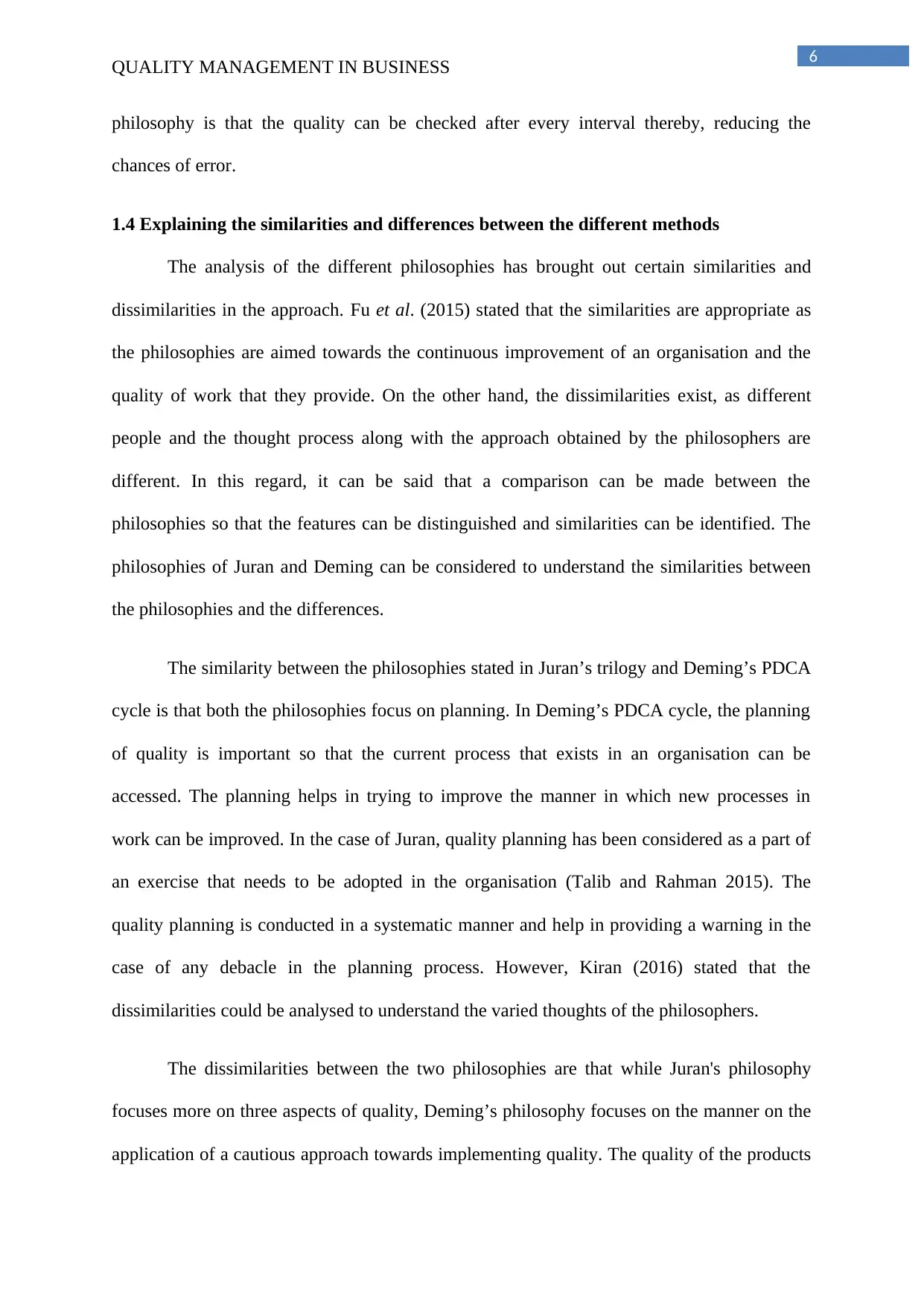
6
QUALITY MANAGEMENT IN BUSINESS
philosophy is that the quality can be checked after every interval thereby, reducing the
chances of error.
1.4 Explaining the similarities and differences between the different methods
The analysis of the different philosophies has brought out certain similarities and
dissimilarities in the approach. Fu et al. (2015) stated that the similarities are appropriate as
the philosophies are aimed towards the continuous improvement of an organisation and the
quality of work that they provide. On the other hand, the dissimilarities exist, as different
people and the thought process along with the approach obtained by the philosophers are
different. In this regard, it can be said that a comparison can be made between the
philosophies so that the features can be distinguished and similarities can be identified. The
philosophies of Juran and Deming can be considered to understand the similarities between
the philosophies and the differences.
The similarity between the philosophies stated in Juran’s trilogy and Deming’s PDCA
cycle is that both the philosophies focus on planning. In Deming’s PDCA cycle, the planning
of quality is important so that the current process that exists in an organisation can be
accessed. The planning helps in trying to improve the manner in which new processes in
work can be improved. In the case of Juran, quality planning has been considered as a part of
an exercise that needs to be adopted in the organisation (Talib and Rahman 2015). The
quality planning is conducted in a systematic manner and help in providing a warning in the
case of any debacle in the planning process. However, Kiran (2016) stated that the
dissimilarities could be analysed to understand the varied thoughts of the philosophers.
The dissimilarities between the two philosophies are that while Juran's philosophy
focuses more on three aspects of quality, Deming’s philosophy focuses on the manner on the
application of a cautious approach towards implementing quality. The quality of the products
QUALITY MANAGEMENT IN BUSINESS
philosophy is that the quality can be checked after every interval thereby, reducing the
chances of error.
1.4 Explaining the similarities and differences between the different methods
The analysis of the different philosophies has brought out certain similarities and
dissimilarities in the approach. Fu et al. (2015) stated that the similarities are appropriate as
the philosophies are aimed towards the continuous improvement of an organisation and the
quality of work that they provide. On the other hand, the dissimilarities exist, as different
people and the thought process along with the approach obtained by the philosophers are
different. In this regard, it can be said that a comparison can be made between the
philosophies so that the features can be distinguished and similarities can be identified. The
philosophies of Juran and Deming can be considered to understand the similarities between
the philosophies and the differences.
The similarity between the philosophies stated in Juran’s trilogy and Deming’s PDCA
cycle is that both the philosophies focus on planning. In Deming’s PDCA cycle, the planning
of quality is important so that the current process that exists in an organisation can be
accessed. The planning helps in trying to improve the manner in which new processes in
work can be improved. In the case of Juran, quality planning has been considered as a part of
an exercise that needs to be adopted in the organisation (Talib and Rahman 2015). The
quality planning is conducted in a systematic manner and help in providing a warning in the
case of any debacle in the planning process. However, Kiran (2016) stated that the
dissimilarities could be analysed to understand the varied thoughts of the philosophers.
The dissimilarities between the two philosophies are that while Juran's philosophy
focuses more on three aspects of quality, Deming’s philosophy focuses on the manner on the
application of a cautious approach towards implementing quality. The quality of the products
Paraphrase This Document
Need a fresh take? Get an instant paraphrase of this document with our AI Paraphraser
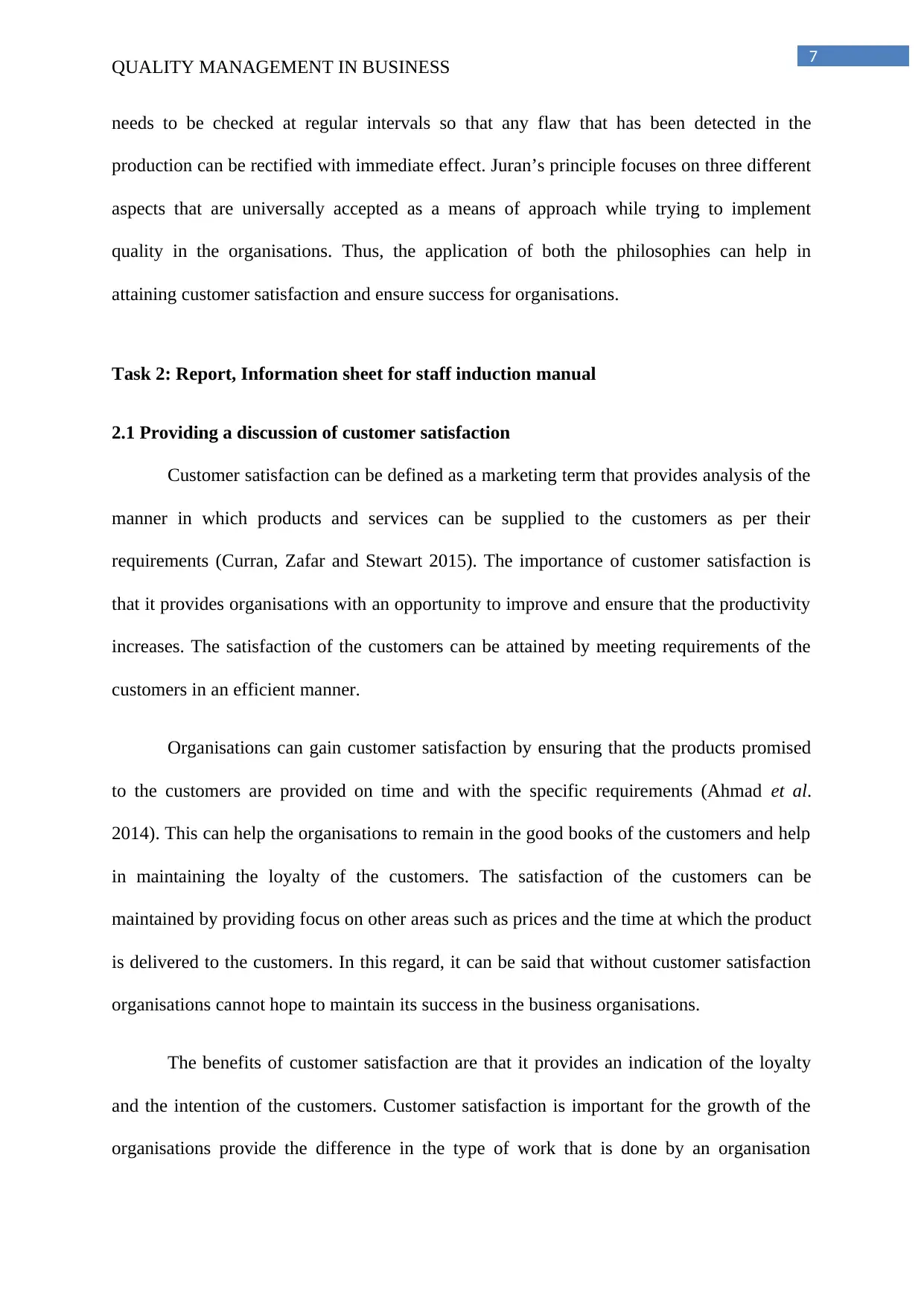
7
QUALITY MANAGEMENT IN BUSINESS
needs to be checked at regular intervals so that any flaw that has been detected in the
production can be rectified with immediate effect. Juran’s principle focuses on three different
aspects that are universally accepted as a means of approach while trying to implement
quality in the organisations. Thus, the application of both the philosophies can help in
attaining customer satisfaction and ensure success for organisations.
Task 2: Report, Information sheet for staff induction manual
2.1 Providing a discussion of customer satisfaction
Customer satisfaction can be defined as a marketing term that provides analysis of the
manner in which products and services can be supplied to the customers as per their
requirements (Curran, Zafar and Stewart 2015). The importance of customer satisfaction is
that it provides organisations with an opportunity to improve and ensure that the productivity
increases. The satisfaction of the customers can be attained by meeting requirements of the
customers in an efficient manner.
Organisations can gain customer satisfaction by ensuring that the products promised
to the customers are provided on time and with the specific requirements (Ahmad et al.
2014). This can help the organisations to remain in the good books of the customers and help
in maintaining the loyalty of the customers. The satisfaction of the customers can be
maintained by providing focus on other areas such as prices and the time at which the product
is delivered to the customers. In this regard, it can be said that without customer satisfaction
organisations cannot hope to maintain its success in the business organisations.
The benefits of customer satisfaction are that it provides an indication of the loyalty
and the intention of the customers. Customer satisfaction is important for the growth of the
organisations provide the difference in the type of work that is done by an organisation
QUALITY MANAGEMENT IN BUSINESS
needs to be checked at regular intervals so that any flaw that has been detected in the
production can be rectified with immediate effect. Juran’s principle focuses on three different
aspects that are universally accepted as a means of approach while trying to implement
quality in the organisations. Thus, the application of both the philosophies can help in
attaining customer satisfaction and ensure success for organisations.
Task 2: Report, Information sheet for staff induction manual
2.1 Providing a discussion of customer satisfaction
Customer satisfaction can be defined as a marketing term that provides analysis of the
manner in which products and services can be supplied to the customers as per their
requirements (Curran, Zafar and Stewart 2015). The importance of customer satisfaction is
that it provides organisations with an opportunity to improve and ensure that the productivity
increases. The satisfaction of the customers can be attained by meeting requirements of the
customers in an efficient manner.
Organisations can gain customer satisfaction by ensuring that the products promised
to the customers are provided on time and with the specific requirements (Ahmad et al.
2014). This can help the organisations to remain in the good books of the customers and help
in maintaining the loyalty of the customers. The satisfaction of the customers can be
maintained by providing focus on other areas such as prices and the time at which the product
is delivered to the customers. In this regard, it can be said that without customer satisfaction
organisations cannot hope to maintain its success in the business organisations.
The benefits of customer satisfaction are that it provides an indication of the loyalty
and the intention of the customers. Customer satisfaction is important for the growth of the
organisations provide the difference in the type of work that is done by an organisation
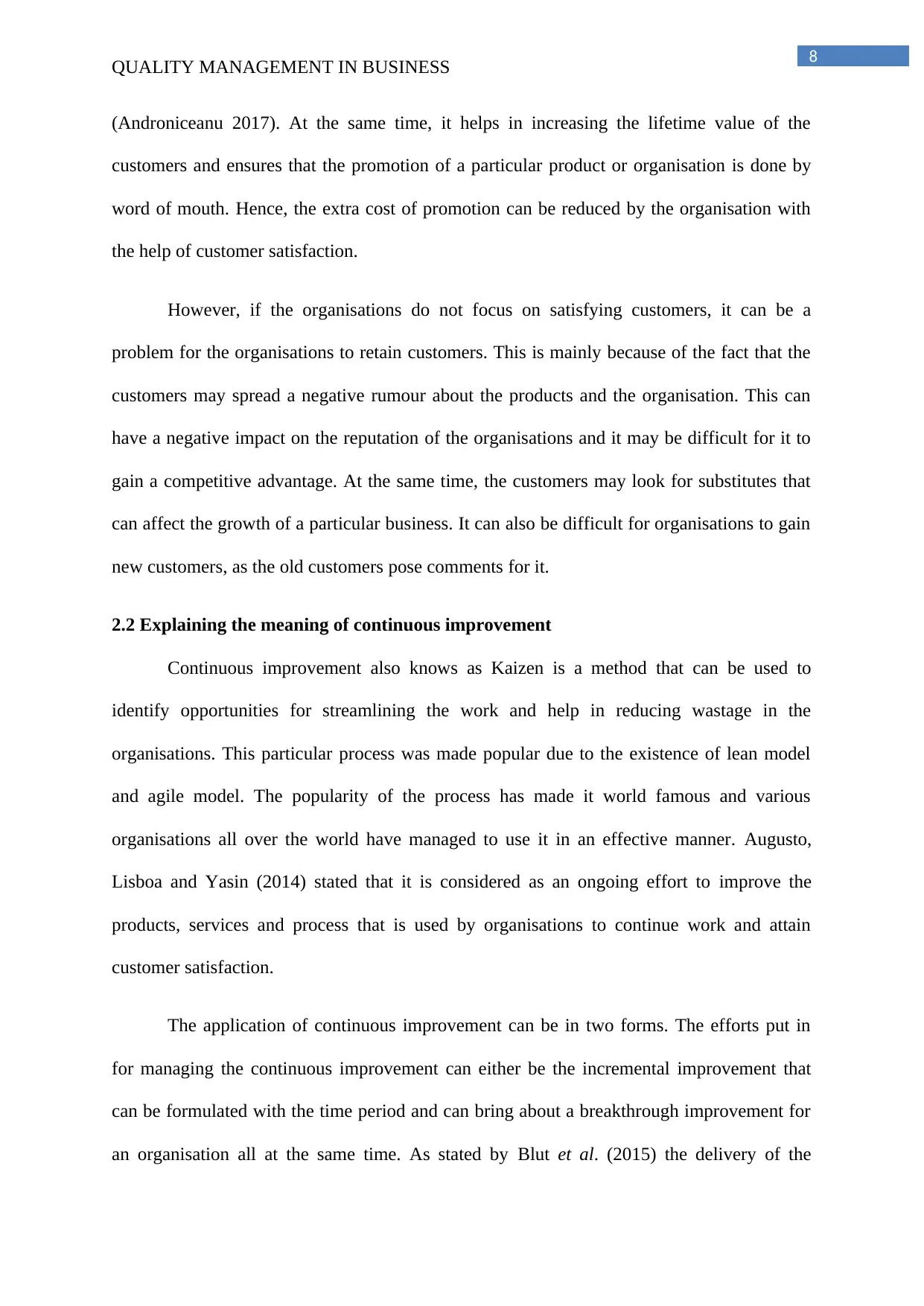
8
QUALITY MANAGEMENT IN BUSINESS
(Androniceanu 2017). At the same time, it helps in increasing the lifetime value of the
customers and ensures that the promotion of a particular product or organisation is done by
word of mouth. Hence, the extra cost of promotion can be reduced by the organisation with
the help of customer satisfaction.
However, if the organisations do not focus on satisfying customers, it can be a
problem for the organisations to retain customers. This is mainly because of the fact that the
customers may spread a negative rumour about the products and the organisation. This can
have a negative impact on the reputation of the organisations and it may be difficult for it to
gain a competitive advantage. At the same time, the customers may look for substitutes that
can affect the growth of a particular business. It can also be difficult for organisations to gain
new customers, as the old customers pose comments for it.
2.2 Explaining the meaning of continuous improvement
Continuous improvement also knows as Kaizen is a method that can be used to
identify opportunities for streamlining the work and help in reducing wastage in the
organisations. This particular process was made popular due to the existence of lean model
and agile model. The popularity of the process has made it world famous and various
organisations all over the world have managed to use it in an effective manner. Augusto,
Lisboa and Yasin (2014) stated that it is considered as an ongoing effort to improve the
products, services and process that is used by organisations to continue work and attain
customer satisfaction.
The application of continuous improvement can be in two forms. The efforts put in
for managing the continuous improvement can either be the incremental improvement that
can be formulated with the time period and can bring about a breakthrough improvement for
an organisation all at the same time. As stated by Blut et al. (2015) the delivery of the
QUALITY MANAGEMENT IN BUSINESS
(Androniceanu 2017). At the same time, it helps in increasing the lifetime value of the
customers and ensures that the promotion of a particular product or organisation is done by
word of mouth. Hence, the extra cost of promotion can be reduced by the organisation with
the help of customer satisfaction.
However, if the organisations do not focus on satisfying customers, it can be a
problem for the organisations to retain customers. This is mainly because of the fact that the
customers may spread a negative rumour about the products and the organisation. This can
have a negative impact on the reputation of the organisations and it may be difficult for it to
gain a competitive advantage. At the same time, the customers may look for substitutes that
can affect the growth of a particular business. It can also be difficult for organisations to gain
new customers, as the old customers pose comments for it.
2.2 Explaining the meaning of continuous improvement
Continuous improvement also knows as Kaizen is a method that can be used to
identify opportunities for streamlining the work and help in reducing wastage in the
organisations. This particular process was made popular due to the existence of lean model
and agile model. The popularity of the process has made it world famous and various
organisations all over the world have managed to use it in an effective manner. Augusto,
Lisboa and Yasin (2014) stated that it is considered as an ongoing effort to improve the
products, services and process that is used by organisations to continue work and attain
customer satisfaction.
The application of continuous improvement can be in two forms. The efforts put in
for managing the continuous improvement can either be the incremental improvement that
can be formulated with the time period and can bring about a breakthrough improvement for
an organisation all at the same time. As stated by Blut et al. (2015) the delivery of the
⊘ This is a preview!⊘
Do you want full access?
Subscribe today to unlock all pages.

Trusted by 1+ million students worldwide
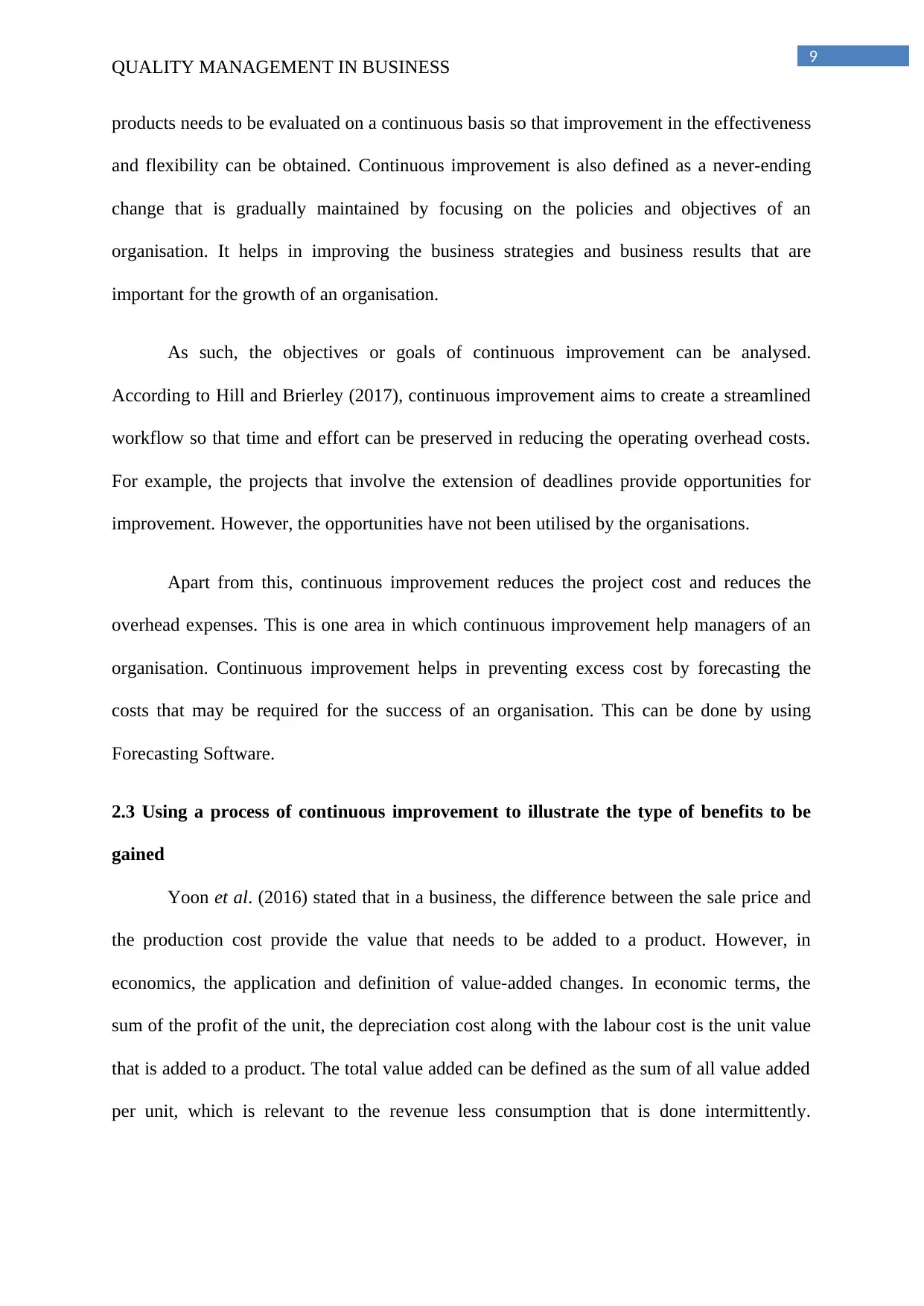
9
QUALITY MANAGEMENT IN BUSINESS
products needs to be evaluated on a continuous basis so that improvement in the effectiveness
and flexibility can be obtained. Continuous improvement is also defined as a never-ending
change that is gradually maintained by focusing on the policies and objectives of an
organisation. It helps in improving the business strategies and business results that are
important for the growth of an organisation.
As such, the objectives or goals of continuous improvement can be analysed.
According to Hill and Brierley (2017), continuous improvement aims to create a streamlined
workflow so that time and effort can be preserved in reducing the operating overhead costs.
For example, the projects that involve the extension of deadlines provide opportunities for
improvement. However, the opportunities have not been utilised by the organisations.
Apart from this, continuous improvement reduces the project cost and reduces the
overhead expenses. This is one area in which continuous improvement help managers of an
organisation. Continuous improvement helps in preventing excess cost by forecasting the
costs that may be required for the success of an organisation. This can be done by using
Forecasting Software.
2.3 Using a process of continuous improvement to illustrate the type of benefits to be
gained
Yoon et al. (2016) stated that in a business, the difference between the sale price and
the production cost provide the value that needs to be added to a product. However, in
economics, the application and definition of value-added changes. In economic terms, the
sum of the profit of the unit, the depreciation cost along with the labour cost is the unit value
that is added to a product. The total value added can be defined as the sum of all value added
per unit, which is relevant to the revenue less consumption that is done intermittently.
QUALITY MANAGEMENT IN BUSINESS
products needs to be evaluated on a continuous basis so that improvement in the effectiveness
and flexibility can be obtained. Continuous improvement is also defined as a never-ending
change that is gradually maintained by focusing on the policies and objectives of an
organisation. It helps in improving the business strategies and business results that are
important for the growth of an organisation.
As such, the objectives or goals of continuous improvement can be analysed.
According to Hill and Brierley (2017), continuous improvement aims to create a streamlined
workflow so that time and effort can be preserved in reducing the operating overhead costs.
For example, the projects that involve the extension of deadlines provide opportunities for
improvement. However, the opportunities have not been utilised by the organisations.
Apart from this, continuous improvement reduces the project cost and reduces the
overhead expenses. This is one area in which continuous improvement help managers of an
organisation. Continuous improvement helps in preventing excess cost by forecasting the
costs that may be required for the success of an organisation. This can be done by using
Forecasting Software.
2.3 Using a process of continuous improvement to illustrate the type of benefits to be
gained
Yoon et al. (2016) stated that in a business, the difference between the sale price and
the production cost provide the value that needs to be added to a product. However, in
economics, the application and definition of value-added changes. In economic terms, the
sum of the profit of the unit, the depreciation cost along with the labour cost is the unit value
that is added to a product. The total value added can be defined as the sum of all value added
per unit, which is relevant to the revenue less consumption that is done intermittently.
Paraphrase This Document
Need a fresh take? Get an instant paraphrase of this document with our AI Paraphraser
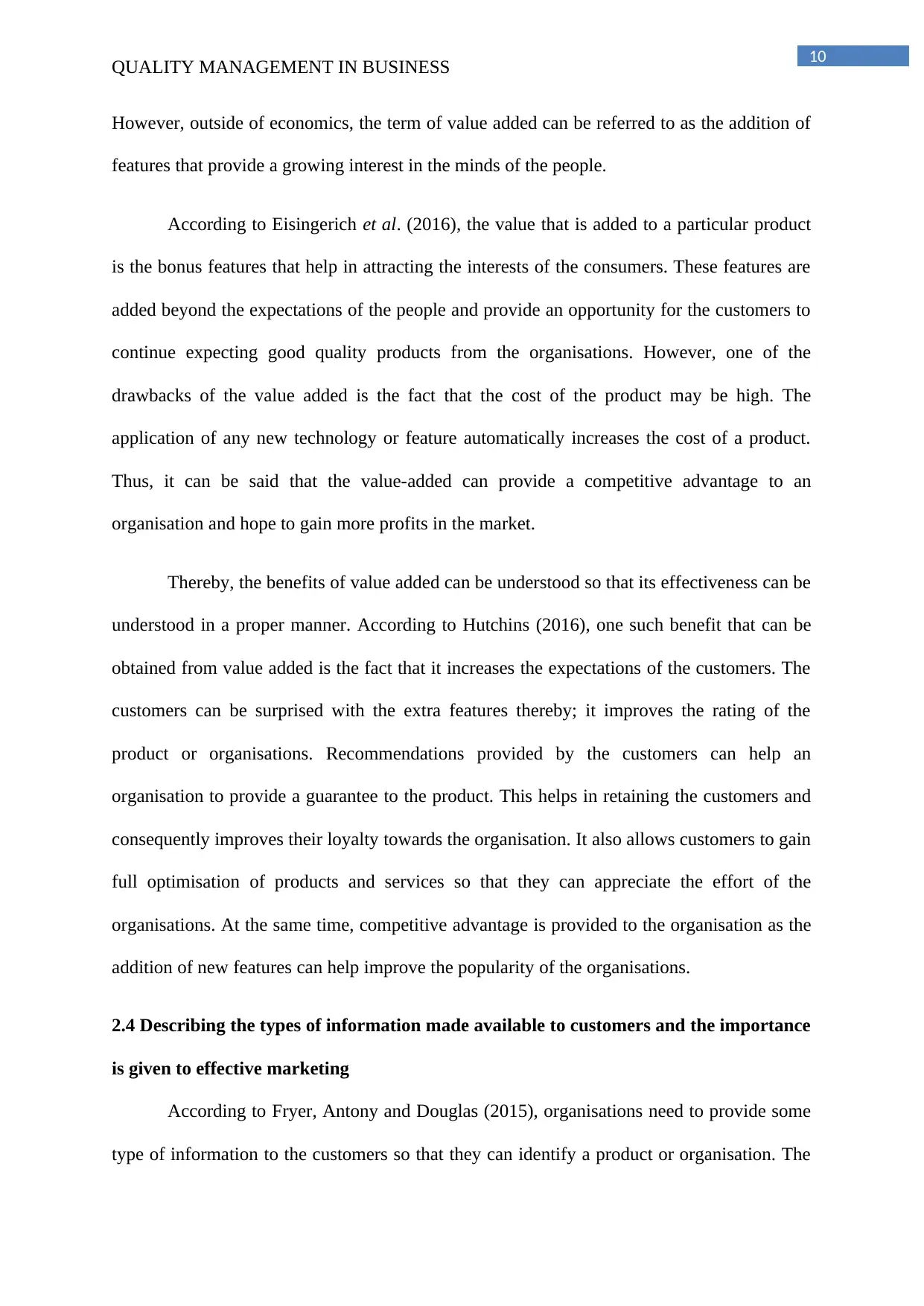
10
QUALITY MANAGEMENT IN BUSINESS
However, outside of economics, the term of value added can be referred to as the addition of
features that provide a growing interest in the minds of the people.
According to Eisingerich et al. (2016), the value that is added to a particular product
is the bonus features that help in attracting the interests of the consumers. These features are
added beyond the expectations of the people and provide an opportunity for the customers to
continue expecting good quality products from the organisations. However, one of the
drawbacks of the value added is the fact that the cost of the product may be high. The
application of any new technology or feature automatically increases the cost of a product.
Thus, it can be said that the value-added can provide a competitive advantage to an
organisation and hope to gain more profits in the market.
Thereby, the benefits of value added can be understood so that its effectiveness can be
understood in a proper manner. According to Hutchins (2016), one such benefit that can be
obtained from value added is the fact that it increases the expectations of the customers. The
customers can be surprised with the extra features thereby; it improves the rating of the
product or organisations. Recommendations provided by the customers can help an
organisation to provide a guarantee to the product. This helps in retaining the customers and
consequently improves their loyalty towards the organisation. It also allows customers to gain
full optimisation of products and services so that they can appreciate the effort of the
organisations. At the same time, competitive advantage is provided to the organisation as the
addition of new features can help improve the popularity of the organisations.
2.4 Describing the types of information made available to customers and the importance
is given to effective marketing
According to Fryer, Antony and Douglas (2015), organisations need to provide some
type of information to the customers so that they can identify a product or organisation. The
QUALITY MANAGEMENT IN BUSINESS
However, outside of economics, the term of value added can be referred to as the addition of
features that provide a growing interest in the minds of the people.
According to Eisingerich et al. (2016), the value that is added to a particular product
is the bonus features that help in attracting the interests of the consumers. These features are
added beyond the expectations of the people and provide an opportunity for the customers to
continue expecting good quality products from the organisations. However, one of the
drawbacks of the value added is the fact that the cost of the product may be high. The
application of any new technology or feature automatically increases the cost of a product.
Thus, it can be said that the value-added can provide a competitive advantage to an
organisation and hope to gain more profits in the market.
Thereby, the benefits of value added can be understood so that its effectiveness can be
understood in a proper manner. According to Hutchins (2016), one such benefit that can be
obtained from value added is the fact that it increases the expectations of the customers. The
customers can be surprised with the extra features thereby; it improves the rating of the
product or organisations. Recommendations provided by the customers can help an
organisation to provide a guarantee to the product. This helps in retaining the customers and
consequently improves their loyalty towards the organisation. It also allows customers to gain
full optimisation of products and services so that they can appreciate the effort of the
organisations. At the same time, competitive advantage is provided to the organisation as the
addition of new features can help improve the popularity of the organisations.
2.4 Describing the types of information made available to customers and the importance
is given to effective marketing
According to Fryer, Antony and Douglas (2015), organisations need to provide some
type of information to the customers so that they can identify a product or organisation. The
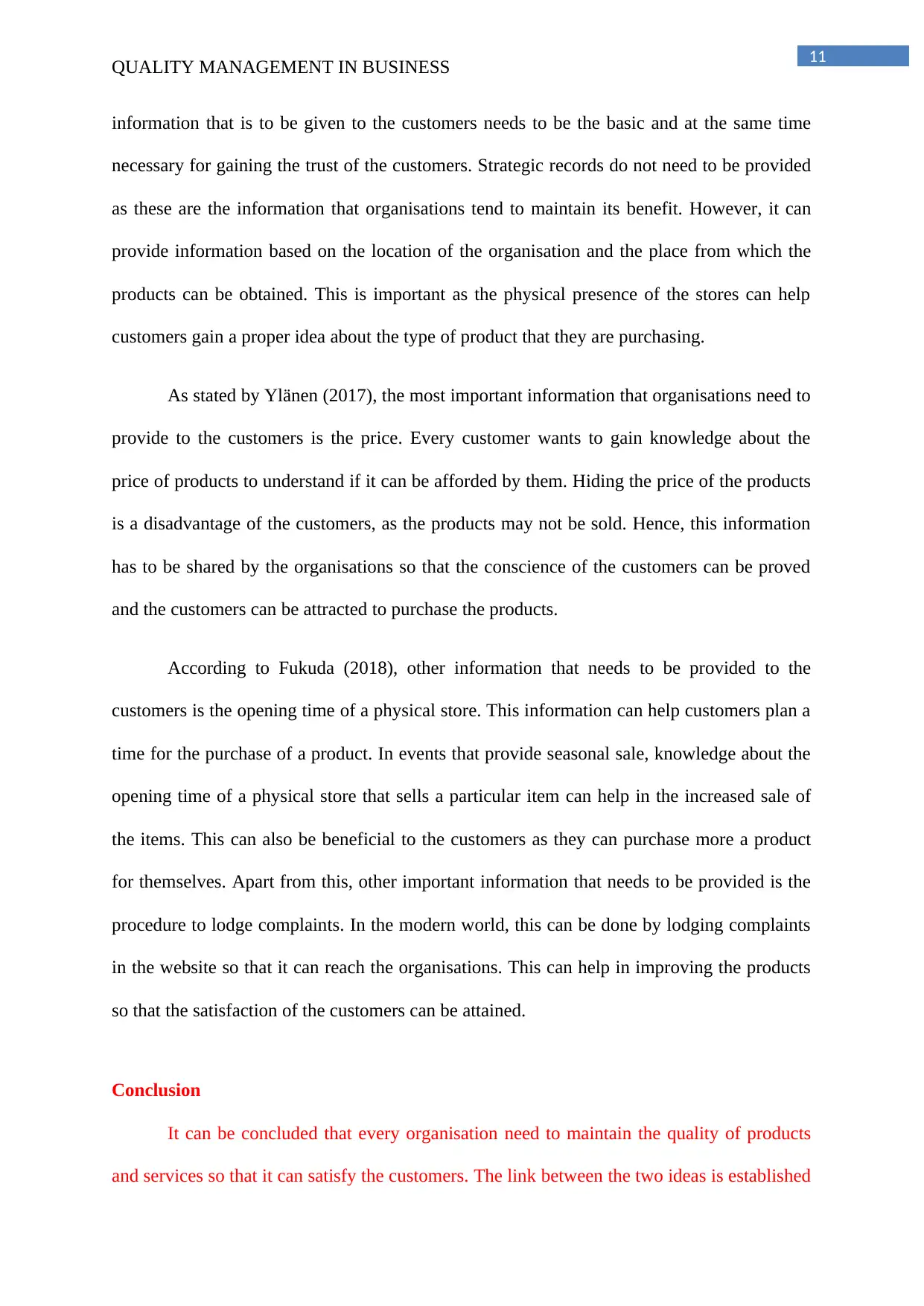
11
QUALITY MANAGEMENT IN BUSINESS
information that is to be given to the customers needs to be the basic and at the same time
necessary for gaining the trust of the customers. Strategic records do not need to be provided
as these are the information that organisations tend to maintain its benefit. However, it can
provide information based on the location of the organisation and the place from which the
products can be obtained. This is important as the physical presence of the stores can help
customers gain a proper idea about the type of product that they are purchasing.
As stated by Ylänen (2017), the most important information that organisations need to
provide to the customers is the price. Every customer wants to gain knowledge about the
price of products to understand if it can be afforded by them. Hiding the price of the products
is a disadvantage of the customers, as the products may not be sold. Hence, this information
has to be shared by the organisations so that the conscience of the customers can be proved
and the customers can be attracted to purchase the products.
According to Fukuda (2018), other information that needs to be provided to the
customers is the opening time of a physical store. This information can help customers plan a
time for the purchase of a product. In events that provide seasonal sale, knowledge about the
opening time of a physical store that sells a particular item can help in the increased sale of
the items. This can also be beneficial to the customers as they can purchase more a product
for themselves. Apart from this, other important information that needs to be provided is the
procedure to lodge complaints. In the modern world, this can be done by lodging complaints
in the website so that it can reach the organisations. This can help in improving the products
so that the satisfaction of the customers can be attained.
Conclusion
It can be concluded that every organisation need to maintain the quality of products
and services so that it can satisfy the customers. The link between the two ideas is established
QUALITY MANAGEMENT IN BUSINESS
information that is to be given to the customers needs to be the basic and at the same time
necessary for gaining the trust of the customers. Strategic records do not need to be provided
as these are the information that organisations tend to maintain its benefit. However, it can
provide information based on the location of the organisation and the place from which the
products can be obtained. This is important as the physical presence of the stores can help
customers gain a proper idea about the type of product that they are purchasing.
As stated by Ylänen (2017), the most important information that organisations need to
provide to the customers is the price. Every customer wants to gain knowledge about the
price of products to understand if it can be afforded by them. Hiding the price of the products
is a disadvantage of the customers, as the products may not be sold. Hence, this information
has to be shared by the organisations so that the conscience of the customers can be proved
and the customers can be attracted to purchase the products.
According to Fukuda (2018), other information that needs to be provided to the
customers is the opening time of a physical store. This information can help customers plan a
time for the purchase of a product. In events that provide seasonal sale, knowledge about the
opening time of a physical store that sells a particular item can help in the increased sale of
the items. This can also be beneficial to the customers as they can purchase more a product
for themselves. Apart from this, other important information that needs to be provided is the
procedure to lodge complaints. In the modern world, this can be done by lodging complaints
in the website so that it can reach the organisations. This can help in improving the products
so that the satisfaction of the customers can be attained.
Conclusion
It can be concluded that every organisation need to maintain the quality of products
and services so that it can satisfy the customers. The link between the two ideas is established
⊘ This is a preview!⊘
Do you want full access?
Subscribe today to unlock all pages.

Trusted by 1+ million students worldwide
1 out of 16
Related Documents
Your All-in-One AI-Powered Toolkit for Academic Success.
+13062052269
info@desklib.com
Available 24*7 on WhatsApp / Email
![[object Object]](/_next/static/media/star-bottom.7253800d.svg)
Unlock your academic potential
Copyright © 2020–2025 A2Z Services. All Rights Reserved. Developed and managed by ZUCOL.




